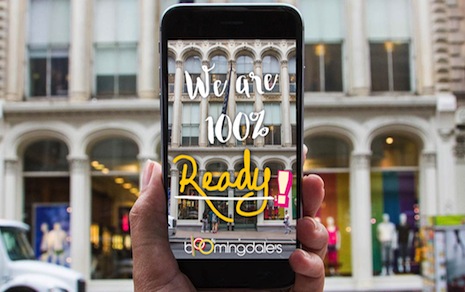 Karl Lagerfeld with Kim Kardashian West on the reality star's gaming app
Karl Lagerfeld with Kim Kardashian West on the reality star's gaming app
With the growth of entertainment on mobile and digital, brands are discovering that by creating marketing efforts with a game-like experience, they make a larger impact.
Italian fashion house Fendi and London’s Harrods department store recently worked together to create a memory game on mobile where users had to match photos of the brand's handbags. Marketers are adopting more strategies such as this in an attempt to better connect with consumers, with market spend in this way likely to overtake traditional spend.
“The key takeaway is that market of online games is growing, more and more people are using there smartphones for the entertainment (aka gaming) and communication,” said Yana Bushmeleva, chief operating officer at Fashionbi, Milan. “People of all ages are involved in this activity, the case of Pokémons last year demonstrated how successful and global the gaming industry is.
“Important to remember that gamification marketing is not necessarily pure online experience, but can be an omni-experience combining online and offline environments,” she said.
Gamifying marketing
A report from Fashionbi is predicting that by 2019, digital media spend will reach between $7 and $8 billion with traditional media staying at $6 billion.
Video games and broadband are the fastest growing media spend categories, and will likely continue to be.
Marketers are dramatically shift to buying ad spend on digital, with products and services as opposed to traditional media.
 Snapchat scavenger hunt from Bloomingdale's
With the popularity of Pokémon Go last summer, many brands such as LVMH beauty retailer Sephora opted to partner with the app to gamify their strategy and drive customer loyalty.
Retailers who implement a form of rewards and loyalty with a game-like experience are likely to see the most success.
Snapchat scavenger hunt from Bloomingdale's
With the popularity of Pokémon Go last summer, many brands such as LVMH beauty retailer Sephora opted to partner with the app to gamify their strategy and drive customer loyalty.
Retailers who implement a form of rewards and loyalty with a game-like experience are likely to see the most success.
 Advertisers should consider partnering with popular game apps such as Pokémon Go
Footwear manufacturer Jimmy Choo also implemented a gamifying experience for the release of sneakers in London, and became one of the first marketers to do so.
Games and brands
The most effective game-like marketing strategies should be able to span offline and online in an omnichannel experience.
Scavenger hunts can be an extremely effective campaign for brands, with consumers of all demographics being interested in interacting with the brand. But the game can also drive in-store sales.
For instance, department store chain Bloomingdale’s generated excitement with an interactive shopping experience.
The retailer partnered with Museum Hack to create #BloomiesHack scavenger hunt shopping experiences at its flagship store on 59th Street in New York. The potential for prizes attracted new and aspirational customers, allowing Bloomingdale’s to initiate a positive lasting relationship with a new market segment (see more).
However, standard mobile video games can also be a big benefit to brands in drawing attention and connecting to consumers and fans.
For instance, Swiss watchmaker Tag Heuer brought its timekeeping capabilities to a new, digital arena to engage with the next generation of consumers.
Tag Heuer made its video game debut in the Gran Turismo Sport, becoming the auto racing franchise’s first watch partner. Providing depth to the partnership, Tag Heuer made an appearance within an in-game digital museum, giving the watchmaker the opportunity to educate racing fans on its history with the sport (see more).
“The most surprising thing is that gamification marketing doesn't mean cheap campaign for mass market brands, but it also could be a tactic for the premium and luxury industry,” Fashionbi's Ms. Bushmeleva said. “Jimmy Choo was one of the first brands to propose a gamification campaign for the launch of new sneakers in London.”
Advertisers should consider partnering with popular game apps such as Pokémon Go
Footwear manufacturer Jimmy Choo also implemented a gamifying experience for the release of sneakers in London, and became one of the first marketers to do so.
Games and brands
The most effective game-like marketing strategies should be able to span offline and online in an omnichannel experience.
Scavenger hunts can be an extremely effective campaign for brands, with consumers of all demographics being interested in interacting with the brand. But the game can also drive in-store sales.
For instance, department store chain Bloomingdale’s generated excitement with an interactive shopping experience.
The retailer partnered with Museum Hack to create #BloomiesHack scavenger hunt shopping experiences at its flagship store on 59th Street in New York. The potential for prizes attracted new and aspirational customers, allowing Bloomingdale’s to initiate a positive lasting relationship with a new market segment (see more).
However, standard mobile video games can also be a big benefit to brands in drawing attention and connecting to consumers and fans.
For instance, Swiss watchmaker Tag Heuer brought its timekeeping capabilities to a new, digital arena to engage with the next generation of consumers.
Tag Heuer made its video game debut in the Gran Turismo Sport, becoming the auto racing franchise’s first watch partner. Providing depth to the partnership, Tag Heuer made an appearance within an in-game digital museum, giving the watchmaker the opportunity to educate racing fans on its history with the sport (see more).
“The most surprising thing is that gamification marketing doesn't mean cheap campaign for mass market brands, but it also could be a tactic for the premium and luxury industry,” Fashionbi's Ms. Bushmeleva said. “Jimmy Choo was one of the first brands to propose a gamification campaign for the launch of new sneakers in London.”
